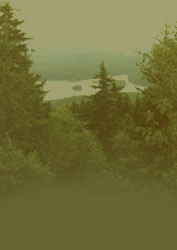|
Do you have something
happening in your corner of Washington? - Please call a member
or e-mail your observations to have them included here
December 2003:
Carol writes: I just saw a beautiful
weasel scurrying along the rocks on the shore of
Halfmoon Pond. Hereís what Fish and Game has to say about
weasels:
Getting ready for winter for some
creatures involves more than just finding the right kind of
food and shelter. For snowshoe hare and several members of
the weasel family, it also means changing their summer brown
coat to a winter white one. New Hampshire has two species
of weasels that change their coat color -- the long-tailed
weasel and the ermine, or short-tailed weasel. In mid-October,
both species begin to lose their reddish-brown coats and usually
by mid-November they are all white.
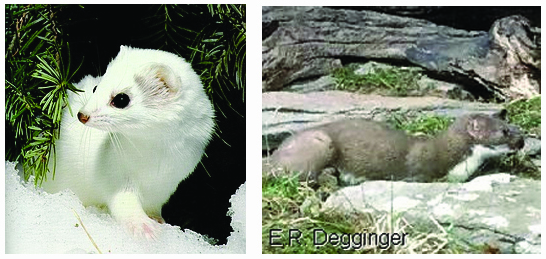
Only the tips of their tails remain black.
In March, they start to lose their white coats and change
back to their reddish-brown summer color. The differences
between the two weasel species are slight. Their tracks give
us the best clue as to which one we are seeing. Weasels leave
behind a "2-2" track pattern. The front feet come down and,
as the front feet leave the ground, the hind feet come in
immediately behind. This type of movement is called bounding.
An ermine track looks like short strides alternating with
long strides, with an occasional drag made between the tracks.
The trail width is a little over an inch and the stride ranges
from 9 to 30 inches. The long-tailed weasel's track is slightly
larger. Ermine are 7 to 13 inches long (without the tail)
and weigh 2 to 7 ounces, about as heavy as an average banana.
Male ermines are larger than females. This can make it difficult
to identify tracks, as a larger male ermine may be as big
as a small long-tailed weasel. Ermine tend to frequent areas
where there is possible prey, like woodpiles, brushpiles and
stone walls. Common foods include mice, chipmunks, voles,
shrews and rabbits. In the summer, they also eat frogs, small
snakes, birds, insects and earthworms. The size of their home
range depends on prey availability. Males have larger home
ranges and regularly make a circuit seeking food. Females
have smaller home ranges of from 5 to 24 acres and hunt with
trails radiating out from their den site. In the winter, female
ermines often hunt subnivean (under the snow), using the tunnels
made by their prey. Ermines can squeeze into tunnels less
than an inch in diameter! When temperatures are low and they
need additional thermal protection, ermines often will rest
in the tunnels and nests of their prey. If there is plenty
of food, ermine may eat the internal organs, brains and muscles
and leave the rest of their prey. So, a pile of mouse carcasses
with the heads missing or the remains of just legs and tails
are signs of ermine activity. They kill instantly by biting
their prey at the base of the neck. In addition, ermine will
cache (store) foods, so they can return to eat more. -
Judy Silverberg, wildlife educator
Last Big Social
Event for Moose: As the
leaves fall off the trees and temperatures drop, moose begin
to think about their weight. The rut is nearly over and winter
is fast approaching. During the rut, food was not a first
priority for the bulls. They were far more interested in courting
as many cows as they could find, and they traveled far and
wide to find them. As a result, they lost quite a bit of weight.
While this sounds like a great weight loss plan -- one many
of us could probably follow successfully! -- it has serious
repercussions for the moose. In order to successfully survive
the cold and poor food resources of the coming winter, moose
must have good fat reserves. To enter the winter as a "lean
mean fighting machine" is tantamount to a death sentence.
So, in mid-October and November, thoughts of romance are set
aside and serious feeding begins. At this time of year, moose
will visit any area that provides good forage. It's not unusual
to walk into a prime clear-cut and find multiple bulls of
various ages, along with a number of cows, feeding together.
Moose will consume up to 40 pounds of leaves, buds and the
new woody growth of young deciduous trees each day. During
the oncoming winter, the only food available will be buds
and twigs, which are low in nutritional value. Moose movements
will be restricted by crust and deep snow, further impacting
their ability to get to available foods. Moose have adapted
to this regimen, and, as winter settles in, their metabolism
and appetite will slow down. They'll rely on the stored fat
supplies within their bodies and slowed metabolism to get
them through the winter. Regardless of how much food is available,
moose will eat and move around less in an effort to conserve
energy, in effect protecting their all-important fat deposits.
So, for the next few weeks, don't be surprised if you see
multiple moose together feeding in a clear-cut or any area
that provides an abundance of deciduous browse. These groups
won't stay together; they will go their separate ways each
evening and eventually part for the winter. Cows will keep
their calves and, occasionally, their yearlings with them,
and bulls may pair up for the winter. But until spring, this
is the last big "social event" for moose and definitely the
last good feed. - Kristine
Bontaites, moose project leader
If you would like to sign up for
Fish and Gameís Wildlife Journal email list:
http://www.wildlife.state.nh.us/Inside_FandG/join_mail_list.htm
The Future of Food
in New England: report from the citizen panel http://www.sustainableunh.unh.edu/fas/justfoods/Future_of_Food.pdf
October 2003:
Monarch Butterflies (Dan
aus plexippus) are migrating! They travel up to three-thousand
miles twice a year: south in the fall and north in the spring.
To avoid the long, cold northern winters, monarchs west of
the Rocky Mountains winter along the California coast. Those
east of the Rockies fly south to the mountain forests of Mexico.
Unlike migrating birds and whales, however, individual monarchs
only make the round-trip once. It is their great-grandchildren
that return south the following fall. Eastern populations
winter in Florida, along the coast of Texas, and in Mexico,
and return to the north in spring. Monarch butterflies follow
the same migration patterns every year. Tens of millions of
these butterflies spend the winter in a mountain forest in
Central Mexico.
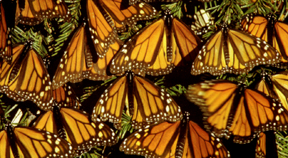
September 2003:
Mushrooms are everywhere!
With our wet, late summer weather there are many mushrooms
to see. Grab your mushroom guide and go exploring for the
many varieties found in our area. A good beginnerís guide
to mushrooms is the National Audubon Society Field Guide to
Mushrooms of North America.
Carol brought in a "Maitakei" also known as "Hen-of-
the-woods" weighing in at 9 lbs. These mushrooms grow
at the base of really large old oak trees. They are an edible
mushroom, and are used medicinally for conditions such as
cancer, high blood pressure and diabetes. These mushrooms
can grow up to 100 lbs. The Japanese call this the dancing
mushroom. It used to be that they could trade this mushroom
pound for pound with silver, so they certainly did a little
dance when they found it. The mushrooms that we collect and
eat are merely the fruiting bodies of an organism that lives
underground or in wood. It doesnít hurt the organism to pick
the fruiting body.
Hen-of-the-Woods (Grifola frondosa)
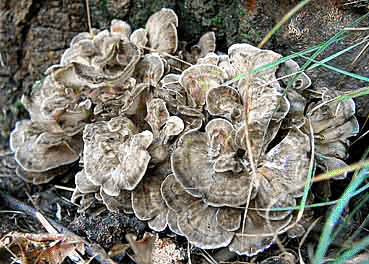
Description: This mushroom really does
look something like a large, ruffled chicken. It grows as
a bouquet of grayish-brown, fan-shaped, overlapping caps,
with offcenter white talks branching from a single thick base.
On the underside, the pore surface is white. It often grows
in the same spot year after year.
When and Where: Summer and fall; on the ground at the base
of trees, or on stumps.
Cautions: Many gilled mushrooms grow in large clumps- remember
that hen-of-the-woods is a pore fungus. This mushroom has
no poisonous look-alikes, but there are some similar species
of pore fungi that are tough and inedible. If what you have
tastes leathery or otherwise unpleasant, you probably didn't
pick a hen-of-the-woods.
Cooking Hints: Use only fresh, tender portions. Simmer in
salted water until tender (requires long, slow cooking), and
serve as a vegetable with cream sauce; or chill after cooking
and use on salads.
Moose visit! Pamela Russo writes - "I was
spending the weekend at a friend's home on Ashuelot Pond in
Washington. I was out on the back deck very early in the morning
(6:45 a.m. on 9/21/03) thinking what a great picture I could
get of the sun coming up on the lake when this little guy
walked through the back yard."
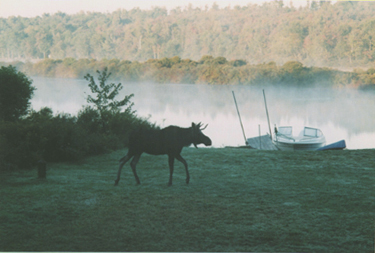
Lots of reports of moose in Ashuelot.
A bald eagle has been visiting the upper Ashuelot.
There seem to be more coyote around than the past couple years.
June 2003:
The Loons are back in
Washington
John Tweedy had a bear at his house last
night (8:44 p.m.)
Carol Andrews reported that the rhodora are
blooming in the Bradford Bog
Don Richard saw a salamander the size of
a spotted, but with no spots
May 2003:
Salamanders are moving
to vernal pools
Mayflowers (trailing arbutus) are in bloom
Listen for woodcock in open fields of about
2 acres or larger, preferably next to a wetland. Listen for
their distinctive "peent" call and watch for their
spectacular mating displays at dusk.
Black flies are coming! The bad news: Approximately
40 species of black flies are known to occur in New Hampshire.
The good news: Of these species, only 4 or 5 are considered
to be significant human biters or annoying.
April 2003:
Spotted Salamanders will
be moving soon. Watch for them on roads, especially on rainy
nights. Get out to see activity in vernal pools.
Suggested Reading: A Field Guide to the animals of Vernal
Pools, by Leo P. Kenney and Matthew R. Burne.
Let's Talk Turkey: The Seabrook nuclear plant
in New Hampshire was locked down Friday (3/21?) after a "potential
intruder" was spotted on a security screen. "Immediately,
we locked down the plant.... We called on the sea coast security,
the New Hampshire State police and the local Seabrook police,"
a plant spokesman said. A security worker, however, told the
FBI he saw "a large bird (probably a wild turkey) with approximately
a 4-foot wingspan fly across the road in front of him" while
he was patrolling the area. In its report to the NRC, Seabrook
noted the turkey sighting "coincided with the location and
time the security operator saw the image on his screen." The
NRC called off the alarm.
Ashuelot River Local Advisory Committee Report on their hike
on 3/15 "Today, several members of the Ashuelot River Local
Advisory Committee and their spouses hiked on snowshoes down
the middle of the Ashuelot River from Mountain Road to the
beginning of Ashuelot Pond. It was so-o-o- beautiful!† And
we saw tracks of otter, beaver, fisher, red fox, gray fox,
snowshoe hare, and mink. Additionally, we saw many bear bites
on balsam firs along the edge of the river. There were also
a few deer rubs (no tracks) and a moose sign. It is an untrammeled
part of the river. The open expanses are lovely, including
a vast marshy area (frozen over now) near the Washington-Lempster
line. There was one house where we began and houses at the
end (as well as noisy snowmobiles on the pond). Otherwise,
all quiet except for the yapping of beagles released to help
hare hunters."† Ann Sweet
(Sullivan)
March 2003:
10' 5.5" of snow so far this winter!
This is the season to hear Owls!
Who's Who in the Owl Family
Owls are much more numerous than people realize. Unless you
live deep in a treeless city, there is likely to be an owl
within walking distance of your house. This is the time of
year when it's easier to find them. A cold night in midwinter
is a good time to locate owls as they call to each other during
their breeding season. Eleven species of owl occur in New
Hampshire. The most common species live in forests, swamps,
woodlots, farms and even suburban yards. None of these owls
are easy to see by day; they spend most of the daylight hours
hidden in tree cavities or perched in thick vegetation. Their
plumage color and pattern is designed to blend in and their
nocturnal activity period makes them difficult to detect.
Owls see and hear what humans cannot. Many special adaptations
combine to make owls superb nocturnal predators. Owls can
see 35 to 100 times better in dim light than we can. Their
eyes are fixed in their sockets. The only way they can move
their eyes is rotating their head. Their large, sensitive
ears, located to the outside of their large eyes enable them
to locate distance and direction of sound with amazing accuracy.
Here is a little bit about the four most common owls found
in New Hampshire.
Saw-whet Owl
At 7-8 inches high, the saw-whet owl is the smallest of the
owls found in New Hampshire. Though this owl does give a rasp
call like the sound of a saw being sharpened, its most common
call is "too-too-too." It can repeat this call more than 100
times per minute. It is most likely to be found perched in
or near a dense stand of evergreens like hemlock or spruce,
and feeds primarily on rodents.
Barred Owl
"Who Cooks for you? Who cooks for you,
all?" is the call of the barred owl, the state's most vocal
owl. This large brown and white owl, with large dark eyes
and no ear tufts, is common. Barred owls also produce a startling
array of wails, screams, whoops and cackles. They are especially
noisy during their March and April courtship period. Prey
include small mammals, frogs, snakes and fish.
Great Horned Owl
Great horned owls are the real "hoot-owls."
Their large size, ear tufts, yellow eyes and white throat
bib of this owl are unmistakable. The deep, rhythmic hoots
can be heard as early as January. Their five-note call has
been likened to the phrase, "Who's awake? Me Too!" An opportunistic
predator, the great horned owl feeds mainly on mammals, including
skunk and porcupine.
Screech Owl
The screech owl is a bit larger than the
saw-whet and is also a cavity nester. These owls have two
typical calls, neither one a screech; the "whinny" is a mournful
descending whistle and the "tremolo" is a one-pitch whistle.
Screech owls feed mainly on insects and small rodents.
February 2003:
John Tweedy remarked on the incredible
ability of squirrels in his yard to find
the acorns quickly and efficiently, even under all this snow.
How do they do that?
Carol Andrews saw a flying squirrel on her
deck a few nights ago. It was eating the seeds that fell into
a hole in the snow under the bird feeder. Apparently flying
squirrels are very common, but we don't see them because they
are nocturnal.
Here are a few facts about the flying squirrel:
There are two species of flying squirrels that are likely
to be here in Washington. The northern flying squirrel prefers
conifers and the southern prefers the mixed deciduous forest.
They don't actually fly, they glide.
Flying squirrels roll their babies into balls for transportation
from nest to nest.
Northern flying squirrels grow fur on the soles of their feet
in winter.
They tend to aggregate in numbers in hollow trees (or in your
house). They are much less territorial than other rodents.
The furry vestment that drapes from wrist to ankle on each
side of the flying squirrel's body is called a patagium. The
patagium contains a complex arrangement of muscles. These
control the direction of flight. Ropelike muscles along the
outer edge hold the airfoil taut. Additional muscles are used
to hold the patagium close to the body when they are on foot.
This patagium also acts as a blanket to keep the babies warm.
Glides of 150 feet are not unheard of, and downslope distances
of 300 feet have been recorded.
Their eyes shine orange at night.
There seem to be a lot of Tufted Titmice
at the bird feeder this winter.
January 2003:
Townspeople have reported seeing groups
of moose traveling together.
Itching to get outside? Watch out for snow fleas!
"There are thousands of these little black things jumping
around on the snow in my front yard. Are they fleas?"
These little critters are referred to as "snow fleas." Actually,
they are not fleas at all. They belong to a very primitive
group of insects named Collembola (CO-LEM-BO-LA), commonly
called spring tails. The group is so primitive that they do
not possess wings. They get around by cocking and releasing
a spring-like mechanism at the tail end of their body and
by crawling.
Snow fleas are active adults from November to March. They
are most apparent when the snow pack starts to thaw in late
winter. Their black color allows them to absorb heat from
the sun. They congregate in great numbers on sunny days to
feed on microscopic algae, bacteria, and fungi on the surface
of the snow and to complete mating. As the trees absorb heat
and the snow melts away from the base of the trees, the snow
fleas move down this pathway to the leaf litter and deposit
their egg load. The young hatch in the leaf litter later in
the spring. They are less than a millimeter long and pinkish
in color. They mature throughout the summer and become sexually
active adults the following fall, usually in November. Snow
fleas do no harm! They are a part of the natural processes
that take place on the forest floor. Snow fleas are part of
that complex of organisms that break down leaf and other organic
matter. They are soil builders. They are not harmful to people
or pets and they won't contaminate foodstuff if they are tracked
into the house.
To view yearly archives of our "New In
Nature" series click on year you wish to see.
2002
2003
2004
2005
2006
2007
2008
2009
2010
2011
2012
|


